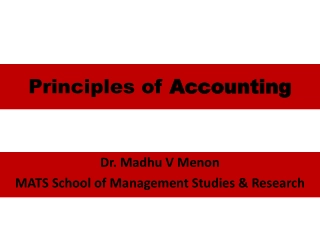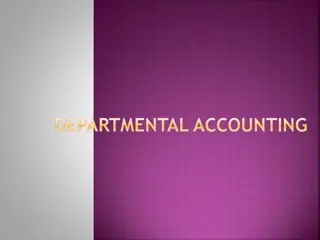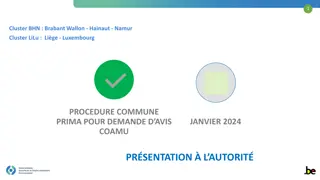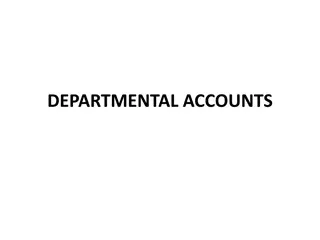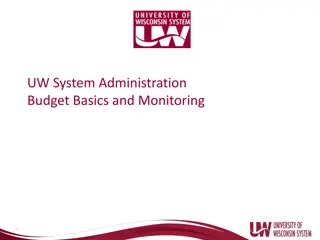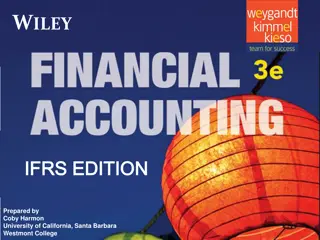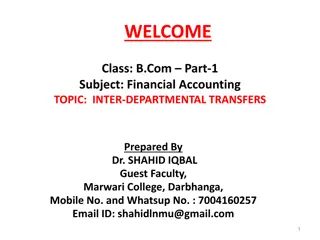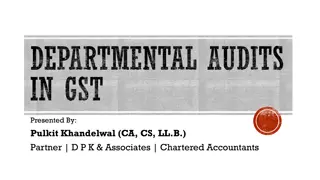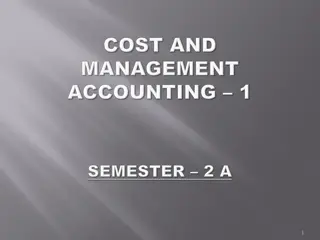Departmental Procedure and Accounting Responsibilities
This content highlights the responsibilities of an accounting officer in managing financial reports, budgets, audits, and preparation of financial statements. It also discusses accounting procedures, standards, and administrative approvals required for departmental works.
Uploaded on Feb 22, 2025 | 0 Views
Download Presentation

Please find below an Image/Link to download the presentation.
The content on the website is provided AS IS for your information and personal use only. It may not be sold, licensed, or shared on other websites without obtaining consent from the author.If you encounter any issues during the download, it is possible that the publisher has removed the file from their server.
You are allowed to download the files provided on this website for personal or commercial use, subject to the condition that they are used lawfully. All files are the property of their respective owners.
The content on the website is provided AS IS for your information and personal use only. It may not be sold, licensed, or shared on other websites without obtaining consent from the author.
E N D
Presentation Transcript
WELCOME TO LECTURE 4 SELESTIAN AUGUSTINO
2.3.0 Departmental procedure and accounting 2.3.1 Accounting Officer Responsibilities Supervise all financial reports and pricing on an everyday basis. Administer all accounts and budgets for various departments, perform audits on tax and prepare reports. Coordinate with internal and external auditors and manage work of all accountants. Analyse management performance and oversaw efficient working of same. Collaborate with accounting and finance team and prepare financial statements on a monthly basis. Prepare various financial reports and submit it to regulatory agencies. Coordinate with chief financial officer and evaluate all fiscal policies and recommend improvements for programs.
2.3.1 Accounting Officer Responsibilities Administer all accounting functions for acquisition and integration of processes. Supervise all functions of Corporate Controller and subsidiaries. Maintain records of all data and evaluate it to recommend product improvements. Work with investor relations of organization and participate in various meetings for all potential investors. Develop and establish all accounting policies for banks. Coordinate with internal and external legal advisors and senior bank personnel. Manage all communication with investor on various investor and earning releases. Analyse potential contracts and mergers and manage all investments for company.
2.3.2 Accounting procedure Accounting procedures are rules or standards that are used to prepare, present, and report the financial status of companies. Generally, accounting procedures cover such topics as how to record financial data, summarize financial data, prepare financial statements, and routine accounting matters. Standards are not directly established by governments, but rather by private sector organizations in which the financial profession sets the standards. In the United States, financial reporting is regulated by the Federal Accounting Standards Advisory Board (FASAB).
2.3.2 Accounting procedure (Administrative approval) For every work (excluding repairs) initiated by, or connected with, the requirements of another department, it is first necessary to obtain the concurrence of the department concerned to the proposals. The formal acceptance by the department concern is termed administrative approval of the work, and is, in effect, an order to execute certain specified works at a stated sum to meet the administrative needs of the department requiring the work. Such approval should not, however, be accorded until the professional authorities have deep scrutiny and found that the proposals are structurally sound and that the preliminary estimate is sufficiently correct for the purpose, hence the approval of the Administrative Department concerned.
2.3.2 Accounting procedure (Technical approval) For every work proposed to be carried out, except petty repairs and annual repairs for which a lump sum provision has been approved by the Superintending Engineer, a properly detailed estimate must be prepared for the approval of competent authority (known as the Technical approval) to the estimate. Such approval can only be accorded in respect of works to be executed through the public works department by government in the public works department, or, where power has been delegated to them, by officers of that department.
2.3.2 Accounting procedure (Payment of bills) Check every invoice/bill you received for accuracy - make sure the details on each document match what you actually ordered and received. Enter the bills/invoices into your bookkeeping system. Write or stamp on them entered or processed to show they have been recorded in the bookkeeping system. File the entered bills away into an alphabetical concertina folder or a punch- hole folder with alphabet tabs. Label the folder Unpaid Invoices . Make sure you only use this folder for unpaid bills so you don t get mixed up with other paper work. Or scan/save them to an electronic filing system. You should receive a Statement from each of your suppliers at least once a month listing all the purchases you made from them during the previous 4 weeks. Match your bills to the Statements or invoices. Take your unpaid bills out of the folder. Make a tick on each Statement next to the ones you have invoices for, and attach them behind. Highlight the overall total on each Statement or Invoice so that you can quickly see what the total is. You can also write 'R' on the Statement or stamp it with a 'reconciled' stamp which indicates that all invoices are accounted for. The next step is to pay the bills on the due date.
2.3.3 Imprest and temporary accounts Imprest account
2.3.3 Imprest and temporary accounts Imprest account An imprest account is one that holds a fixed amount of money and is replenished after a certain period of time. A good example of an imprest account is a petty cash system that may be replenished on a daily, weekly or monthly basis. An imprest account limits what can be spent within a fixed time period. For example, if the weekly petty cash limit is 100,000 Tshs, it is not possible to spend more. The account is replenished every week depending on how much has been used, always topping it up to 100,000 Tshs. It is also easier to account for spending with an imprest account as the system requires documentation with receipts and invoices for each withdrawal. Since the amount of money is a known quantity, each period's spend is easy to calculate.
2.3.3 Imprest and temporary accounts Temporary account A temporary account is an account that begins each fiscal year with a zero balance. At the end of the year, its ending balance is shifted to a different account, ready to be used again in the next fiscal year to accumulate a new set of transactions. Temporary accounts are used to compile transactions that impact the profit or loss of a business during a year. Examples of temporary accounts are: Revenue accounts Expense accounts (such as the cost of goods sold, compensation expense, and supplies expense accounts) Gain and loss accounts (such as the loss on assets sold account) Income summary accounts The balances in these accounts should increase over the course of a fiscal year; they rarely decrease. The balances in temporary accounts are used to create the income statement.
2.3.4 Cash Book A Cash Book is a type of subsidiary book where cash (or) bank receipts and cash (or) bank payments made during a period are recorded in a chronological order. Receipts are recorded on the debit (the left hand side), and payments are recorded on the credit ( right hand side). Entries are recorded just like a ledger account with the help of To and By . The number of cash transactions in a business is generally large, hence it is convenient to have a separate cash book to record such transactions. There are 3 types of a cash book: Single Column Cash Book Double Column Cash Book Triple Column Cash Book
2.3.4 Cash Book Single Column Cash Book Also known as a simple cash book or a one column cash book, a single column cash book has one relevant column on each side which shows the simple receipts and payments of cash. Receipts are shown on the left side and the right side is for payments. Double Column Cash Book Also known as a two column cash book, a double column cash book is the one which has a Bank column in addition to the regular Cash column. Just like the other type of books, it records receipts from cash and bank on the left side and payments, on the right side. Triple Column Cash Book Also called a three column cash book, a triple column cash book has Cash , Bank and Discount Allowed on the receipt on the left side and Cash , Bank and Discount Received on the payments are on the right side of the cash book. Cash discount is recorded, when payments are made in cash or by check.
2.3.5 Accounting for consumable materials Material types for consumable materials are: UNBW-Non valuated material only quantity based accounting NLAG- Non stock material No quantity or value updating
2.3.6 Measurement Book (M-Book or MB) Measurement Book in Civil engineering is a book used by any department or agency of construction site to record the work done by the contractor with all the direction, dimension and quantity with date of execution of work. One may say, it is the book used on site for recording the measurements to calculate the materials required to the further construction process, work done by the contractor or materials received or services rendered. It is made by the government. Measurement Book is generally used by Junior Engineer or Assistant Engineer, who is responsible on the field or site of project.
2.3.6 Measurement Book (M-Book or MB) Importance It is used for making payments of work done to the contractor Helps to calculate out the quantity of item in length, square metre, cubic metre, tonne etc. Recording the measurements of work completed by any subcontractors It maintains the accounts of work in construction projects
2.3.6 Measurement Book (M-Book or MB) Record entry in Measurement Book (MB) First of all write down date of measurement taken. Item of BOQ (Bill of Quantity) is explained to understand that what is the measurement and from where it is taken. Serial Number of new measurement is written with Item number of BOQ as show in above table. Because it tell us the new record serial and from where same item is taken so that BOQ item serial number is useful for quick checking. Clearly mention the unit of measurement like: Cubic metre or Cumec for volumetric measurement like excavation, concrete etc. Square metre or Sqm for areal measurement like plastering work which have fixed depth etc. metre or m for length measurement for standard or fixed width item like pipe line etc. The total quantity of measurement is calculated on same page.
Measurement Book format Depth or Height or Thickness Breadth or Width Total Quantity Item NO. Description of Item Number Length Quantity 1/1 2/4 3/5 4/7 5/8
2.3.7 Work charged establishment Work charged establishment is an establishment of which the expenses are chargeable to works. The pay and allowances of the employees who are engaged on a work charged establishment are usually shown under a specified sub-head of the estimated cost of works. The work charged employees are engaged for execution of a specified work or project and their engagement comes to an end on completion of the work or project. Example During the construction of a project considerable number of skilled supervisors, work assistance, watch men etc., are employed on temporary basis. The salaries of these persons are drawn from the L.S. amount allotted towards the work charged establishment. that is, establishment which is charged directly to work. an L.S. amount of 1 to 2% of the estimated cost is provided towards the work charged establishment.
2.3.8 Nominal Muster Roll (N.M.R) Nominal Muster Roll (N.M.R) is used for keeping a complete record of attendance, payment made, unpaid wages and work done by daily labour engaged on the execution of works. It is the basic records of payment made to daily labour. After the payment is made, the Muster Roll is kept as a Voucher. It is very important record and strictly in accordance with the rules. Nominal Muster Roll means any `daily wage employee' or any person who is employed on the basis of payment of daily wages. It may also includes a person employed on consolidated pay either, on full-time or part-time or piece-rate basis or as a work-charged employee
2.3.9 Daily Labour Report (D.L.R) Day labor (or day labour) is work done where the worker is hired and paid one day at a time, with no promise that more work will be available in the future. It is a form of contingent work. Daily labor report is the report of the work done where the worker is hired and paid one day at a time, with no promise that more work will be available in the future. Few examples of daily labor report are illustrated in the next slides.
EXERCISE 2 2 Marks questions 1. Mention three main forms of business organization. 2. What is a joint-stock company? 3. What do you mean by co-operative society? 4. Considering Tanzania as a case study, define SOE with real examples. 5. What is decentralization? 6. What does contract works insurance cover? 7. What is meant by personality? 8. What do you mean by integrity and ethics? 9. Your worker has high degree of integrity at work. What does it mean?
10. What is human relation according to Aubrey Sanford and Keith Davis? 11. Distinguish imprest account from temporary account. 12. What is Cash Book? 13. What is M-Book in Civil engineering? 14. Explain in short about work charged establishment. 15. Explain in short N.M.R and D.L.R.
4 Marks questions 1. Briefly explain any four (4) characteristics of a co-operative society. 2. Elaborate the types of a co-operative society. 3. There are several qualities of efficient construction manager. Explain any four (4) of them. 4. How do you manage different personalities at work place? 5. How do you demonstrate integrity in the workplace? 6. How do you demonstrate a strong work ethic at your work place? 7. With explanation and simple diagrams discuss three types of Cash Book. 8. Discuss the record entry in M-Book in Civil engineering. 9. How is M-Book helpful in Civil engineering?
12 Marks questions 1. Discuss in detail the important merits of joint stock company. 2. How do you delegate the right tasks to the right people in a project? 3. Define human relations according to Robert Owen. With at least five (5) points discuss how to improve human relations at work place? 4. Discuss in detail the accounting officer responsibilities.


